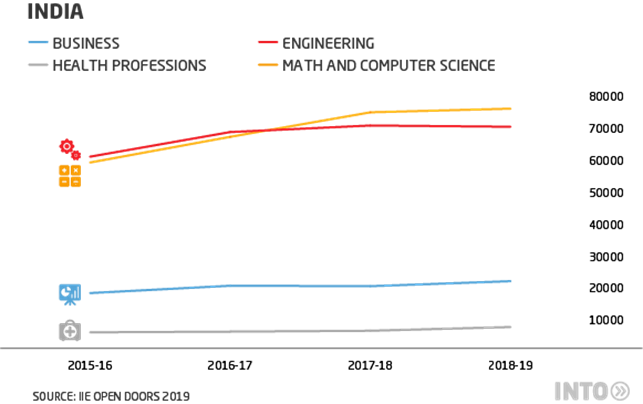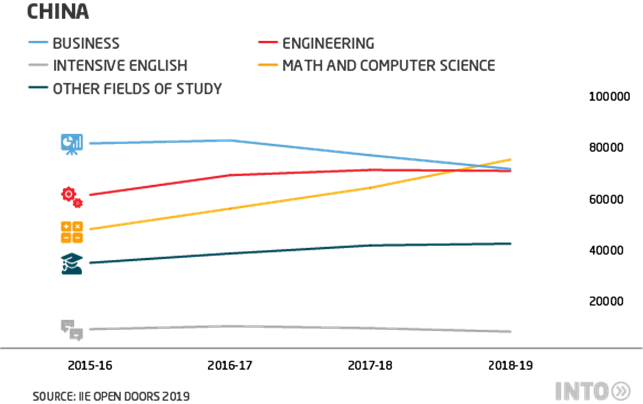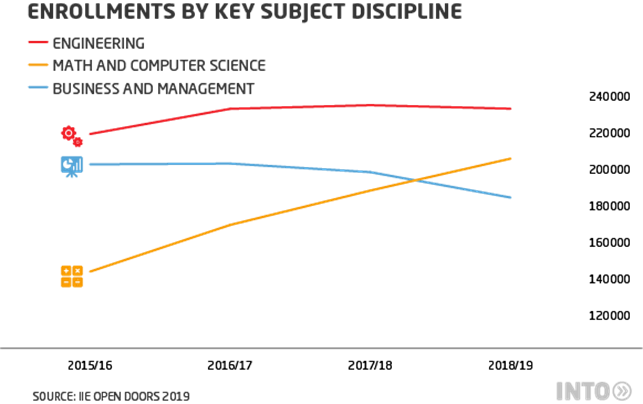Paradigm shift: The rise of math and computer science among international students

To kick off International Education Week, the Institute of International Education (IIE) released its 70th Open Doors Report, which outlines international student mobility trends in the United States during the 2018/19 academic year. The report indicates that there was a 0.05% increase in the total number of international students in the U.S. in 2018/19, 52% of which pursued degrees or completed optional practical training (OPT) in science, technology, engineering, or mathematics (STEM).
While international students in the U.S. continued to pursue engineering programs more than any other subject in 2018/19, spikes in the number of students pursuing math and computer science programs drove what little international enrollment growth there was in the U.S. during the last academic year. In fact, math and computer science deposed business as the second-most popular pursuit of international students in the U.S., revealing a paradigm shift in students’ motivations to study at American universities. As the number of tech jobs continues to grow around the world, international students in the U.S. increasingly devote time and tuition to math and computer science degrees—not the business degrees for which they have traditionally come to the States.
Of the 203,461 international students studying or completing OPT in math and computer science in 2018/19, nearly three quarters (148,285) came from India or China. Math and computer science surpassed engineering to become the most pursued fields of study among Indian students in 2017/18. Meanwhile, for Chinese students in the U.S., business was the most popular field of study until 2017/18. In 2018/19, a 17.7% increase in the population of Chinese students of math and computer science, combined with a 7.1% decline in the number of Chinese business students, led to the most significant shift in Chinese students’ course preferences in the last five years.


This shift has been some time in the making. The population of Chinese students pursuing degrees or completing OPT in math and computer science in the U.S. has grown by 58.7% over the last four years, compared to a 12.5% drop in the number of Chinese students of business. Simultaneously, the number of Indian students of math and computer science has increased by 22.5%, compared to a 13.5% uptick in the number of engineering students.

Overall, the number of international students who come to the U.S. for math and computer science programs increased by 44% between 2017/18 and 2018/19. In the same period, the total number of international students of business and management fell by 9%.
The trends revealed in the 2019 Open Doors Report exist not only in the context of an increasingly technology-driven world, but also that of an American immigration policy that allows international STEM students to work in the U.S. two years longer than peers pursuing other subjects. Math and computer science programs’ increased popularity among international students suggests, then, that those who leave their home countries to study at American universities do so in anticipation of opportunities for post-graduate employment.
In terms of American higher education, this shift serves as a guidepost for the many universities that face difficulty enrolling international student cohorts at a time when global perceptions of the U.S. as a welcoming study destination have taken a hit. Such institutions may grow their international populations by increasing recruitment efforts for their math and computer science programs and redesigning their business programs to focus on analytics and technology. Likewise, the U.S. may well affirm its place as the world’s top study destination by redoubling its efforts to open its doors to international students interested in STEM subjects.